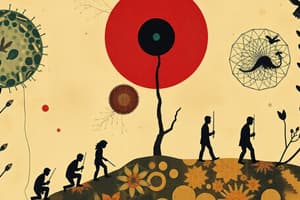Podcast
Questions and Answers
What explains how species evolve over time?
What explains how species evolve over time?
- Germ Theory of Disease
- Microscopy
- Theory of Biogenesis
- Theory of Evolution (correct)
Which tool is primarily used to amplify small segments of DNA?
Which tool is primarily used to amplify small segments of DNA?
- PCR (Polymerase Chain Reaction) (correct)
- CRISPR
- DNA Sequencing
- Microscopy
What theory proposes that many diseases are caused by microorganisms?
What theory proposes that many diseases are caused by microorganisms?
- Theory of Evolution
- Theory of Biogenesis
- Germ Theory of Disease (correct)
- CRISPR
What does the theory of biogenesis assert?
What does the theory of biogenesis assert?
What ethical considerations arise in the field of biology?
What ethical considerations arise in the field of biology?
What is the study of heredity and variation called?
What is the study of heredity and variation called?
Which branch of biology is concerned with the study of ecosystems?
Which branch of biology is concerned with the study of ecosystems?
What is the basic unit of life as defined by cell theory?
What is the basic unit of life as defined by cell theory?
Which process involves the conversion of light energy into chemical energy?
Which process involves the conversion of light energy into chemical energy?
In biological classification, what comes after the kingdom level?
In biological classification, what comes after the kingdom level?
What is homeostasis?
What is homeostasis?
Which of the following processes is crucial for building proteins in cells?
Which of the following processes is crucial for building proteins in cells?
What do we call the phenomenon where species change over time through natural selection?
What do we call the phenomenon where species change over time through natural selection?
Flashcards are hidden until you start studying
Study Notes
Definition of Biology
- The scientific study of living organisms and their interactions with the environment.
Branches of Biology
- Zoology: Study of animals.
- Botany: Study of plants.
- Microbiology: Study of microorganisms.
- Genetics: Study of heredity and variation.
- Ecology: Study of ecosystems and the relationships between organisms and their environment.
- Evolutionary Biology: Study of the origins and changes in the diversity of life over time.
- Cell Biology: Study of the structure and function of cells.
Key Concepts
- Cell Theory: All living organisms are made of cells; cells are the basic unit of life.
- Gene Theory: Traits are inherited through genes, which are passed from parents to offspring.
- Homeostasis: The ability of an organism to maintain stable internal conditions despite external changes.
- Evolution: The process through which species change over time through natural selection.
Biological Classification (Taxonomy)
- Domain: Archaea, Bacteria, Eukarya
- Kingdom: Animalia, Plantae, Fungi, Protista
- Phylum: Major groups within kingdoms
- Class: Grouping of organisms within phyla
- Order: Further division within classes
- Family: Groups of related organisms within orders
- Genus: First part of the scientific name, grouping closely related species
- Species: Second part of the scientific name, unique identifier for individuals
Fundamental Processes
- Photosynthesis: Process by which plants convert light energy into chemical energy.
- Cellular Respiration: Process converting biochemical energy from nutrients into ATP, releasing waste products.
- DNA Replication: The process of copying DNA before cell division.
- Protein Synthesis: The process by which cells build proteins based on genetic instructions.
Levels of Biological Organization
- Molecule: Chemical structures consisting of at least two atoms.
- Cell: Basic unit of life.
- Tissue: Group of similar cells performing a common function.
- Organ: Structure made of different tissues working together.
- Organ System: Group of organs working together for a specific function.
- Organism: Individual living entity.
- Population: Group of organisms of the same species in a certain area.
- Community: Different populations interacting in a shared environment.
- Ecosystem: Community plus the nonliving environment.
- Biosphere: Global sum of all ecosystems.
Important Biological Theories
- Theory of Evolution: Explains how species evolve over time through natural selection.
- Germ Theory of Disease: Proposes that many diseases are caused by microorganisms.
- Theory of Biogenesis: States that living organisms arise from preexisting life.
Tools and Techniques in Biology
- Microscopy: Use of microscopes to see small organisms or structures.
- DNA Sequencing: Process for determining the precise order of nucleotides in DNA.
- PCR (Polymerase Chain Reaction): Technique to amplify small segments of DNA.
- CRISPR: Gene-editing technology allowing for precise modifications to DNA.
Ethical Considerations
- Topics like genetic engineering, cloning, and conservation raise ethical questions in the field of biology.
- Importance of biodiversity and the need for sustainable practices to protect ecosystems.
Definition of Biology
- Biology is the scientific study of living organisms, analyzing their characteristics, functions and interactions with the environment.
Branches of Biology
- Zoology studies animals, their behavior, habitats, and evolutionary relationships.
- Botany focuses on plants, their structure, growth, and biological processes.
- Microbiology investigates microorganisms, including bacteria, viruses, fungi, and protists.
- Genetics delves into heredity and variation, exploring how genetic information is passed on and how it affects traits.
- Ecology examines the interactions between organisms and their environment, encompassing factors such as population dynamics, food webs, and ecosystem stability.
- Evolutionary Biology studies the origins and evolution of life, exploring processes like natural selection and adaptation.
- Cell Biology focuses on the structure and function of cells, the fundamental units of life.
Key Concepts
- Cell Theory states that all living organisms are composed of cells and cells are the basic units of life.
- Gene Theory explains that traits are inherited through genes passed from parents to offspring, influencing characteristics.
- Homeostasis is the ability of organisms to maintain stable internal conditions despite external fluctuations.
- Evolution is the gradual process of change in species over time, driven by mechanisms like natural selection.
Biological Classification (Taxonomy)
- Organisms are classified hierarchically into eight levels:
- Domain: Broadest category, encompassing Archaea, Bacteria, and Eukarya.
- Kingdom: Includes groups like Animalia, Plantae, Fungi, and Protista.
- Phylum: Larger groupings within kingdoms.
- Class: Further divisions within phyla.
- Order: Groups of related organisms within classes.
- Family: Groups of related organisms within orders.
- Genus: First part of the scientific name, grouping closely related species.
- Species: Second part of the scientific name, uniquely identifying individuals within a genus.
Fundamental Processes
- Photosynthesis is the process by which plants convert light energy into chemical energy (glucose), releasing oxygen as a byproduct.
- Cellular Respiration involves the breakdown of nutrients to release energy in the form of ATP (adenosine triphosphate), providing energy for cellular processes.
- DNA Replication is the process of copying the entire DNA molecule before cell division, ensuring that each new cell has a complete set of genetic instructions.
- Protein Synthesis is the process of creating proteins based on the genetic code stored in DNA. It involves two key steps: transcription (copying DNA into mRNA) and translation (using mRNA to assemble amino acids into proteins).
Levels of Biological Organization
- Biological organization is hierarchical, with each level building upon the previous one:
- Molecule: The fundamental building blocks of life, consisting of two or more atoms.
- Cell: The basic unit of life, capable of carrying out all life processes.
- Tissue: A group of similar cells working together to perform a specific function.
- Organ: A structure composed of different tissues working in coordination.
- Organ System: A group of organs that work together to perform a major bodily function.
- Organism: An individual living being capable of independent existence.
- Population: A group of organisms of the same species living in a particular area.
- Community: Different populations interacting within a shared environment.
- Ecosystem: A community of organisms and their physical environment, interacting as a functional unit.
- Biosphere: The global sum of all ecosystems, encompassing all life on Earth.
Important Biological Theories
- Theory of Evolution: Explains how species change over time through mechanisms like natural selection, genetic variation, and adaptation.
- Germ Theory of Disease: Proposes that many diseases are caused by microorganisms like bacteria, viruses, and fungi.
- Theory of Biogenesis: States that living organisms arise from pre-existing life and not spontaneously from non-living matter.
Tools and Techniques in Biology
- Microscopy: Utilizing various microscopes to observe small organisms and structures invisible to the naked eye, providing detailed insights into the microscopic world.
- DNA Sequencing: Determines the precise order of nucleotides (A, T, C, G) in DNA, revealing the genetic code and facilitating various biological studies.
- PCR (Polymerase Chain Reaction): A technique that amplifies small segments of DNA, making it possible to study specific genes or regions of DNA from minute samples.
- CRISPR: A revolutionary gene-editing technology that allows precise modifications to DNA sequences, enabling targeted changes to genetic information.
Ethical Considerations
- Advances in biology raise ethical questions related to genetic engineering, cloning, and conservation.
- The preservation of biodiversity and sustainable practices are fundamental to protecting ecosystems and ensuring the balance of life on Earth.
Studying That Suits You
Use AI to generate personalized quizzes and flashcards to suit your learning preferences.




